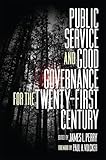Public Service and Good Governance for the Twenty-First Century / ed. by James L. Perry.
Material type: TextPublisher: Philadelphia : University of Pennsylvania Press, [2020]Copyright date: ©2020Description: 1 online resource (312 p.) : 7 illusContent type:
TextPublisher: Philadelphia : University of Pennsylvania Press, [2020]Copyright date: ©2020Description: 1 online resource (312 p.) : 7 illusContent type: - 9780812252040
- 9780812296914
- Civil service -- United States
- Public administration -- United States
- POLITICAL SCIENCE / Public Affairs & Administration
- Francis Fukuyama
- Paul Volcker
- Volcker Alliance
- characteristics good leader
- federal contractors
- federal public service reform
- governance reform
- leadership education
- public leadership
- public policy education
- public service
- 351.73 23
- JK421 .P825 2020
- online - DeGruyter
| Item type | Current library | Call number | URL | Status | Notes | Barcode | |
|---|---|---|---|---|---|---|---|
 eBook
eBook
|
Biblioteca "Angelicum" Pont. Univ. S.Tommaso d'Aquino Nuvola online | online - DeGruyter (Browse shelf(Opens below)) | Online access | Not for loan (Accesso limitato) | Accesso per gli utenti autorizzati / Access for authorized users | (dgr)9780812296914 |
Frontmatter -- CONTENTS -- Foreword -- Introduction -- Chapter 1. Catch-22 Government: Federal Performancein Peril -- Part I. Disruptive Influences -- Chapter 2. Beyond the Financial Crisis: Regulators Confront New Challenges from Technological (R)evolution -- Chapter 3. Big Data, AI, and Algorithmic Platforms: Implications for Governing and Public Policy -- Chapter 4. Political Disruption: Is Amer i ca Headed Toward Uncontrollable Extremism or Partisan Goodwill? -- Part II. Emerging Government and Governance -- Chapter 5. The Intrinsic Functions of Government -- Chapter 6. Reframing American Institutions: A Look Ahead to Midcentury -- Chapter 7. Is Federal Public Service Reform Still Possible? Toward a “Volcker Rule” for Federal Contractors -- Chapter 8. Good Government: Per sis tent Challenges, Smart Practices, and New Knowledge Needed -- Part III. Public Service and Public Leaders -- Chapter 9. A Personal Reflection on the Importance of Public Service -- Chapter 10. Competencies of the Public Service in Challenging Regulatory Times -- Chapter 11. Upending Public Policy Education -- Chapter 12. The Emerging Public Leader: Characteristics, Opportunities, and Challenges -- List of Contributors -- Index -- Acknowledgments
restricted access online access with authorization star
http://purl.org/coar/access_right/c_16ec
Expert analysis of American governance challenges and recommendations for reformTwo big ideas serve as the catalyst for the essays collected in this book. The first is the state of governance in the United States, which Americans variously perceive as broken, frustrating, and unresponsive. Editor James Perry observes in his Introduction that this perception is rooted in three simultaneous developments: government's failure to perform basic tasks that once were taken for granted, an accelerating pace of change that quickly makes past standards of performance antiquated, and a dearth of intellectual capital that generate the capacity to bridge the gulf between expectations and performance. The second idea hearkens back to the Progressive era, when Americans revealed themselves to be committed to better administration of their government at all levels—federal, state, and local.These two ideas—the diminishing capacity for effective governance and Americans' expectations for reform—are veering in opposite directions. Contributors to Public Service and Good Governance for the Twenty-First Century explore these central ideas by addressing such questions as: what is the state of government today? Can future disruptions of governance and public service be anticipated? What forms of government will emerge from the past and what institutions and structures will be needed to meet future challenges? And lastly, and perhaps most importantly, what knowledge, skills, and abilities will need to be fostered for tomorrow's civil servants to lead and execute effectively?Public Service and Good Governance for the Twenty-First Century offers recommendations for bending the trajectories of governance capacity and reform expectations toward convergence, including reversing the trend of administrative disinvestment, developing talent for public leadership through higher education, creating a federal civil service to meet future needs, and rebuilding bipartisanship so that the sweeping changes needed to restore good government become possible.Contributors: Sheila Bair, William W. Bradley, John J. DiIulio, Jr., Angela Evans, Francis Fukuyama, Donald F. Kettl, Ramayya Krishnan, Paul C. Light, Shelley Metzenbaum, Norman J. Ornstein, James L. Perry, Norma M. Riccucci, Paul R. Verkuil, Paul A. Volcker.
Mode of access: Internet via World Wide Web.
In English.
Description based on online resource; title from PDF title page (publisher's Web site, viewed 08. Aug 2023)


